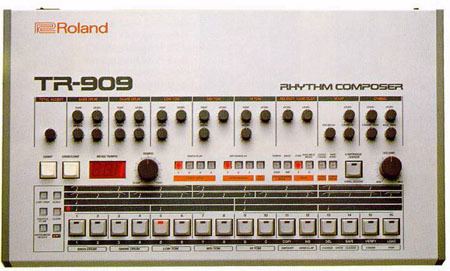Polyphony 12 voices | Dates 1984-1985 Timbrality none | |
 | ||
Price US$1,195UK£999JP¥189,000 Synthesis type Analog Subtractive andDigital Sample-based Subtractive | ||
The Roland TR-909 Rhythm Composer is a partially analog, partially sample-based, drum machine introduced by the Japanese Roland Corporation in 1984. The brainchild of Tadao Kikumoto, the engineer behind the Roland TB-303, it features a 16-step step sequencer and a drum kit that aimed for realism and cost-effectiveness. It is fully programmable, and like its predecessor, the TR-808, it can store entire songs with multiple sections, as opposed to simply storing patterns. It was the first MIDI-equipped drum machine. Around 10,000 units were produced.
Contents
History
The 909 was launched three years after its 808 forebear, changing the game slightly by offering a part-analogue, part-sample-based sound generation hybrid. As with the 808, the 909 sounded a long way from the more realistic alternatives from Linn and Oberheim that had all but secured the upper ends of the drum machine market. As with the TB-303, the realism of the TR-909 was limited by technical constraints, and this showed when the machines were released at relatively low prices before its rise in popularity, coinciding with the beginnings of techno and acid. More expensive, sample-based drum computers were better at faithfully reproducing real drum sounds, while the TR-909 sounded synthetic.
One of the first Roland instruments to be equipped with MIDI, the TR909 combined analogue sound generation of its drum sounds with digital samples for its cymbal and hi-hat sounds. With a powerful sequencer that let you chain 96 patterns into songs of up to 896 measures, numerous controls that let you tailor the sounds, and extras such as shuffle and flam, it undoubtedly sounded more realistic than its predecessors, and was moderately successful, even though the advent of purely sample-based drum modules would soon cause its demise. But, like the TR808 before it, nobody could have predicted the reverence in which the TR909 would eventually come to be held.
The TR909 soundset is part of Roland's AIRA TR-8 drum machine.
On September 9, 2016, 30+ years after the TR909 was introduced, Roland declared the day "909 Day." The event is being celebrated by the unveiling of over 30 new instruments, one of which was an updated version of the TR909 called the TR-09. Unlike its purely analog ancestor, the TR-09 is powered by the same analog modeling technology that powers the AIRA TR-8. The TR-09 is part of Roland's Boutique product line.
Sounds
The drum kit contains the following sounds:
All drums except for the hi-hats and cymbals are synthetically generated; there is an oscillator circuit with a dedicated filter and envelope curve. The hi-hats and cymbals are 6-bit samples, compressed and combined with a volume envelope curve (and tuning) to allow slight modification. Thanks to the analog circuitry, various aspects of the drum sound can be modified (pitch, attack, decay).
There is also a feature called "accent"—a primitive means of humanizing the drumbeat. In a simplified model of a drummer and a kit, the loudness of the sound created would basically depend on the velocity at which the drummer hits a given part of the kit. A human drummer can emphasize certain notes by playing them louder, and the accent parameter provides a means to boost a particular step.
Part of the charm of the TR-909 comes from its 16-step sequencer — the 16 buttons along the bottom of the interface correspond to the 16th notes of a single bar in 4/4 meter. For example, punching the buttons 1, 5, 9 and 13 on the bass drum part would create a simple "four to the floor" beat. Multiple patterns can be grouped or chained together which allows the user to create drum patterns that are longer than one bar in length or, alternatively, create drum patterns in compound meters outside of 3/4 or 4/4.
While the sequencer is running, a light runs from step 1 to step 16.
Editing
The TR-909 has several editing modes: pattern editing where one focuses solely on the 16 steps, and track editing, which allows for chaining various patterns in a row. Because it has MIDI, it's also possible to control other instruments with the sequencer.
This machine and its unique sequencer (both Roland and other manufacturers used either a grid-based sequencer, showing the dots on an LCD, or another method that did not display the pattern at all) were the basis for so-called grooveboxes — self-contained compact synthesizer workstations with rudimentary keyboards and pattern-based sequencers, aimed at creators of electronic music, using sample-based sound generation and a number of realtime controls.
1980s
1990s
2000s/2010s
Clones
Other manufacturers have made similar devices:
Hardware
(Grooveboxes are not included in this list as they contain more than just drums, though they may have copied the principle of the 16-step sequencer.)
